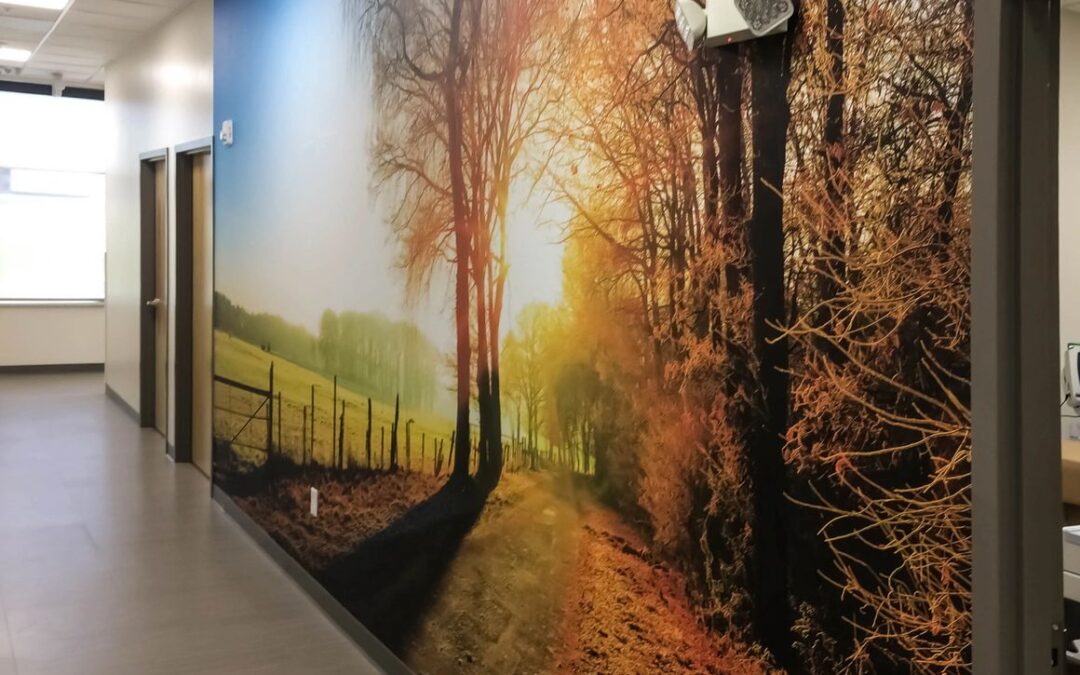
by admincat | Dec 20, 2021 | Art Benefits, Wall Graphics
The benefits of wall graphics within our artwork programs for healthcare settings have become one of the fastest-growing trends. It’s not hard at all to see why. An enlarged image or text can look amazing on a wall. Wall graphics are versatile and can be a beautiful focal point in an area that has a lot of space or in a long narrow hallway where there may not be room for framed artwork. Wall graphics/ coverings are now available in so many different materials including those that can withstand the need to be bleached or sanitized.
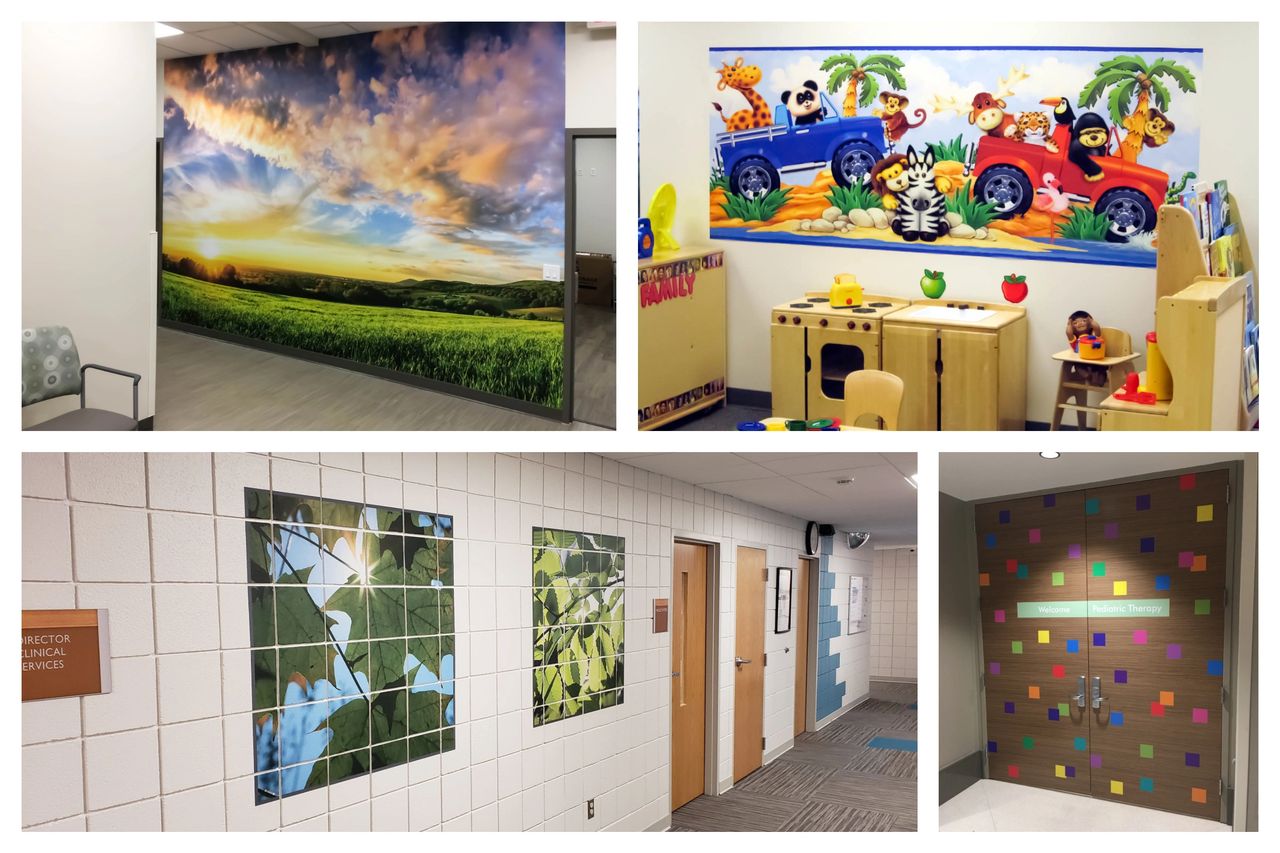
“It’s also important to consider that healthcare environments tend to experience abuse from cart traffic and aggressive cleaning protocols. Designers should seek the owner’s input about locating certain substrates in challenging locations and testing surfaces with environmental services staff. Many custom-printed substrates, like vinyl wall covering and resin, will withstand bleach cleaning, but it’s important to know in advance. Another option is to sandwich an image between two layers of more durable material, such as glass if cleaning chemicals are a concern.” (Blake)
The Art Consultants at Health Environment Art Services will work with your project manager and staff to ensure durability concerns and find an image or custom graphic design that will fit your needs as well as your budget. We have Graphic Designers on staff that can help create a design as well as an extensive library of imagery such as natural landscapes to choose from. HEAS has completed many projects featuring wall graphics and we know that we can help you with your needs too!
Contact us today to get started!
Health Environment Art Services
76 West Seegers Road, Arlington Heights, Illinois 60005, United States
Corporate Headquarters: (847) 843-3636
Credits:
Carolyn Fleetwood Blake, Simplifying Supergraphics In Healthcare Environments
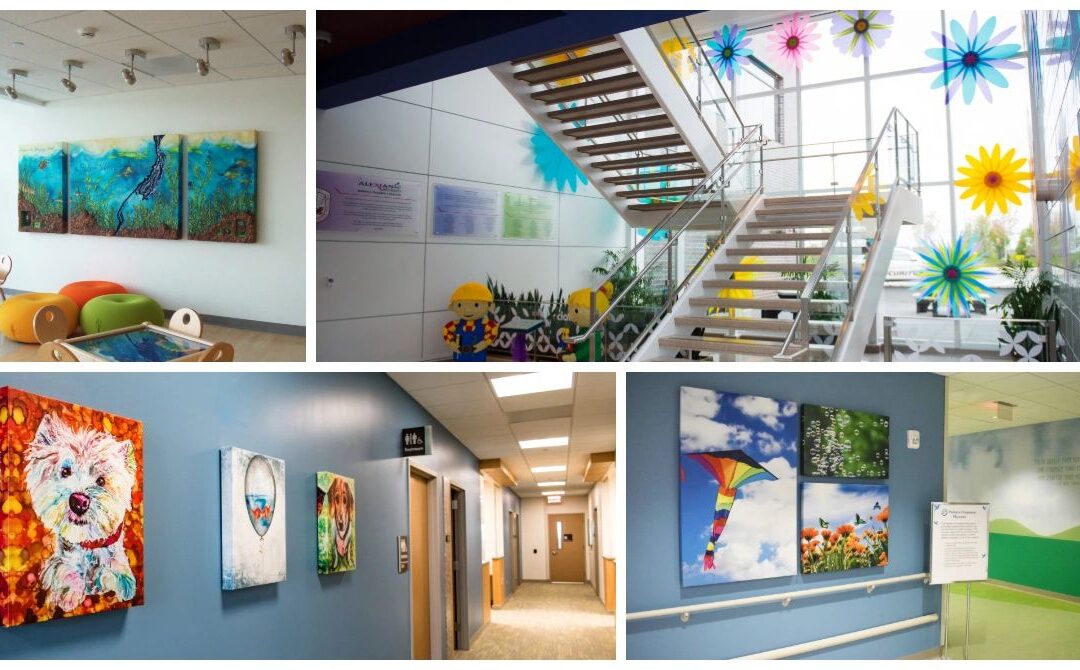
by admincat | Nov 15, 2021 | Art Benefits, Art Consultant
No matter if it’s a hospital, a doctor’s, or a dentist’s office, children and adults alike will experience some form of stress and anxiety during their visit to a medical environment. This once seemingly normal reaction to these sorts of appointments is quickly becoming a thing of the past. And good riddance too!
Not only has evidence-based design become a growing field for hospitals, but it is also being used in smaller pediatric health and dentistry practices. Our Art Consultants at Health Environment Art Services have worked with a number of healthcare facilities of all sizes including children-specific environments. Focuses on techniques for alleviating anxiety, fear, and phobias through positive interior support design and environmental distractions.
Theming Environments & positive reinforcement
Creating a themed environment for pediatric children, both the child and their parents are immediately comfortable and put at ease; therefore reducing their anxiety and improving medical outcomes. Creating a happy experience for visitors will help instill positive reinforcement for them so they can return again without the usual type of fear and anxiety that typically accompany medical visits.
Dr. Barbara Sheller, DDR, MDS, the Chief of Pediatric Dentistry at Seattle Children’s Hospital explains that it is critical for a pediatric environment to provide warm, welcoming signals to reinforce patients and parents that they have come to the right place. The most important signals to soothe and satisfy social-emotional connections that influence childhood anxiety include bright, upbeat colors, kid-targeted activities in the waiting room, and the sincerity of staff at the practice (Sheller).

One example of a project HEAS has completed with Amita Health Alexian Brothers Women and Children’s Hospital in 2014. Commissioned through a donation from Claire’s Stores, Inc., the large-scale, kinetic sculpture in the hospital’s lobby is named “Bloom.” (See image left) The custom-designed, kid-friendly sculpture features flowerlike forms and includes a control dock at youngsters’ height to allow them to move the forms without touching them. The artists commissioned to create Bloom, Joe O’Connell, and Blessing Hancock, of Creative Machines Inc. in Tucson, Ariz., say they hope it will help young patients and visitors “find comfort and reassurance in the hospital setting.” The sculpture, they add, “celebrates the life and the impulse to enjoy it.”
Working within healthcare environments is something we take pride in. To see more children’s healthcare environments we have completed throughout the years please click here to view our portfolio.
Works Cited
Sheller, Barbara. “The Power of Positivity in Managing Pediatric Patient and Parent Behavior.” Dental Economics. N.p., 22 Mar. 2016. Web. 16 June 2016.
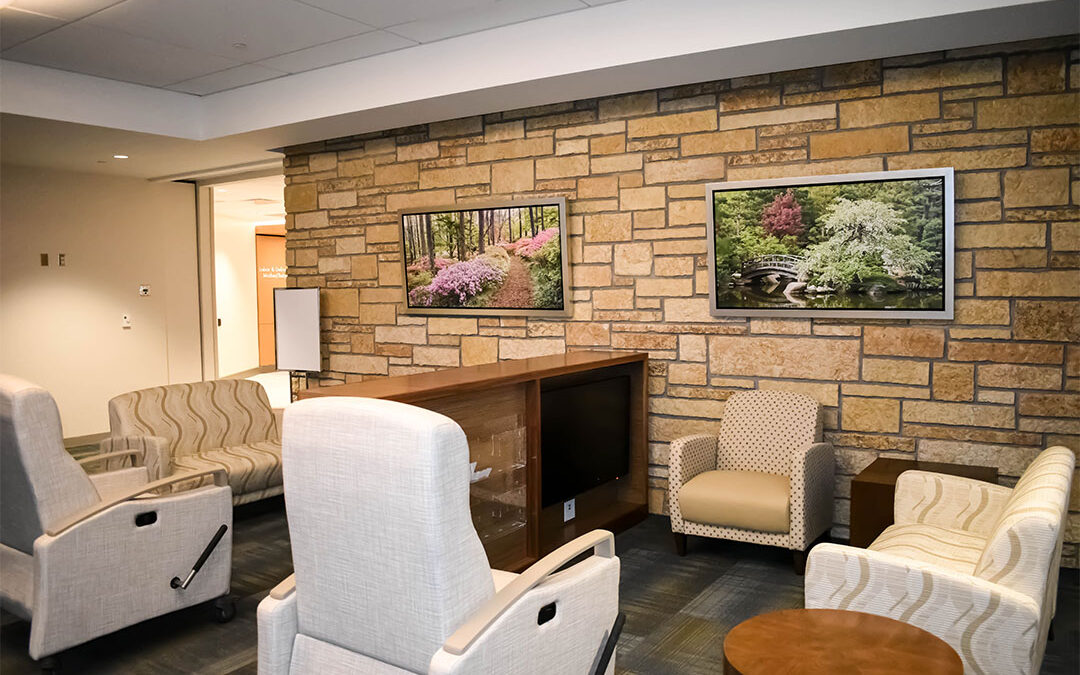
by admincat | Oct 11, 2021 | Art Benefits, Art Healing
Beyond Traditional Treatment: Establishing Art As Therapy
By Elaine Poggi
“Photography is the story I fail to put into words.”
— Destin Sparks
“Photography is a way of feeling, of touching, of loving. What you have caught on film is captured forever… It remembers little things, long after you have forgotten everything.”
— Aaron Siskind
I couldn’t understand why an important hospital-like Barnes Jewish Hospital in St. Louis would hang abstract art in its halls, waiting rooms, and patient rooms. I was confused by it, and so was my 85-year-old mother, who had been admitted for Non-Hodgkin’s lymphoma. I had left my family in Florence, Italy, to assist with her almost three-month stay. After the first month, I decided to take action.
I gathered from my mother’s home my enlarged photographs of nature, which I had given to her over the years. I placed them on the white walls and over the abstract art in her room. Immediately, we both felt more relaxed and comforted. The hospital staff and other patients also came to enjoy the photos. As it turned out, my photos were the last colorful images of beauty that my mother saw before passing away in the hospital.
The Foundation for Photo/Art in Hospitals an American nonprofit organization is participating in an Italian research project titled “Beyond traditional treatment… Art as therapy,” promoted by the Italian Oncological Group of Clinical Research (Il Gruppo Oncologico Italiano di Ricerca Clinica [GOIRC]), and sponsored by Eli Lilly Italia. It is being coordinated by a Florentine research group, consisting of myself; Francesco Di Costanzo, MD, Director of the Oncology Department, Massimo Rosselli, MD, Director of Psycho-oncology, and Laura Bellotti and Roberta Perfetto, psychologists at Careggi Hospital in Florence; and Franco Pasti, Professor of Architecture at the University of Florence.
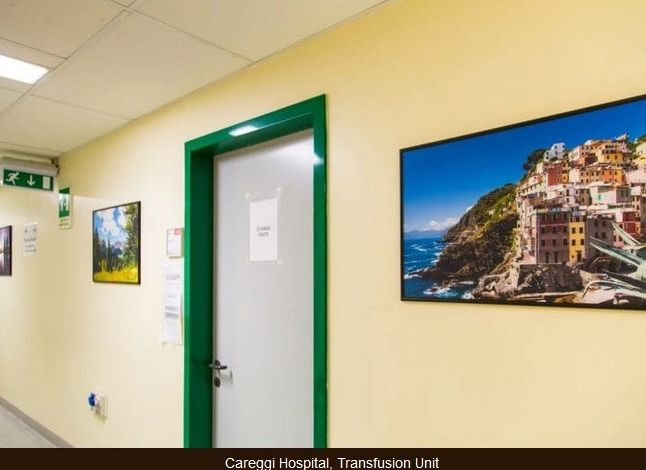
The purpose of this study—the first of its kind in Italy—is to appraise cancer patients’ perceptions of the hospital environment before and after the placement of 30 nature photographs in their treatment area. The photos, donated by the Foundation for Photo/Art in Hospitals, are images of landscapes, Tuscan hillsides, marine life, tropical beaches, flowers, and animals. The supposition is that the viewing of nature photography can have a positive impact on patients.
The first phase of the research was the construction and validation of “The Test of Perception of the Hospital Environment,” created expressly for this research. The test is a 23-item questionnaire, with reference to five images of hospital rooms, with and without art displayed on the walls; six nature images; and six abstract images. To analyze the test’s validity and reliability, the pilot questionnaire was administered to 120 patients at Careggi Hospital—60 experimental cancer patients and 60 internal medicine controls. The first exploratory phase, which took over a year to complete, has confirmed the initial supposition that naturalistic images can have a positive impact on patients.
The second phase of the research is currently underway. This consists of testing 600 cancer patients from five cancer centers throughout Italy—Ancona, La Spezia, Messina, Perugia, and Terni—while they are receiving treatment; half will be the control group. In addition to the newly constructed questionnaire, three other psychological tests will be administered: SF-36 (Health Survey Questionnaire), TCI-R (Temperament and Character Inventory), and HADS (Hospital Anxiety and Depression Scale).
An abstract of the research has been accepted for presentation at the IPOS 8th World Congress of Psycho-Oncology in Venice, Italy, October 18-21, 2006, and will be published in the Journal of Psycho-Oncology.
In Italy, there was once a relationship between hospital structures and visual arts occurring throughout the history of great hospital institutions of the Renaissance, such as Santa Maria Nuova in Florence, Santa Maria Della Scala in Siena, the hospital of Ceppo in Pistoia, and San Carlo in Milan. Works of art have been placed mainly in the sacred spaces of the hospitals. Always there was a sense of collaboration between architects and artists, and the value of art as a cure was recognized implicitly.
Today, unfortunately, most Italian hospitals reflect a lack of attention to art. They tend to be cold, sterile, and impersonal. Hospital budgets do not include funding for art. In this context, our research has been very well received by the staff and patients of the five cancer centers.
When the Foundation was created four years ago, most of our photo projects were in the United States and Italy. Since then, there has been a great expansion to hospitals in other areas of the world, including Haiti, Malawi, Kenya, Poland, Japan, the Maldives, Switzerland, Brazil, and Canada. From my interactions with physicians, nurses, and administrators, I’ve found that although the physical structures and designs of the hospitals vary, the people are the same. The patients are seeking relief from their illnesses and the staff is seeking to provide such relief. It is my belief, which we are now attempting to document, that nature photography can contribute to that effort.
As the Chief Operating Officer of the Hospital Albert Schweitzer in Haiti said, “Whether it be the proud mothers of newborns, malnourished children, or patients of all ages recuperating from accidents or being treated for AIDS or tuberculosis, I know that viewing these photos cannot help but lift their spirits and give them a few moments away from their pain and suffering. If that is the case, then they will have been provided a good dose of ‘medicine’ that even the best trained doctor would not be able to provide.” HD
Elaine Poggi, originally from Southern Illinois, moved to Florence, Italy, after college to pursue studies in classical piano. After giving concerts throughout the United States and Italy for several years, she married and began a family in Florence and took up nature photography.
Photography is a very popular medium that we work with at Health Environment Art Services. Whatever our client’s vision whether it’s a mix of photography, paintings by local artists, or prints we are dedicated to fulfilling those exact needs. Please visit our portfolio to see a vast majority of the projects we have completed with hospitals across the country. Contact us today if you have a current project you are seeking help with.

by admincat | Sep 15, 2021 | Art Benefits, Art Healing
Art of Healing
Healthcare design over the last few decades has changed dramatically, and we can all agree it’s for the better. Long gone are the days of seeing hospitals with halls that were once plain and dull are now being filled with bright colors featuring artwork that not only awe visitors but also has the power to heal and calm observers.
The professional Art Consultants at Health Environment Art Services are experts in using evidence-based designs just like this in their artwork programs. Whether it’s a floor to ceiling theme for a children’s hospital, framed art for an Oncology practice, or whimsical wall graphics in a maternity ward. We have completed large projects featured in brand-new state-of-the-art healthcare facilities that are over 1 million square feet.
The precision and practice doctors strive to have in their work ethic is something we too endeavor to use in every new project or challenge that comes our way. Working side by side with your architect or project manager to help make the vision of the finished space come to life is what we love best about what we do.
We would like to share this video“The Art of Healing at UCSF Medical Center at Mission Bay” which explains in wonderful detail how the artists who participated in the art projects at UCSF Medical Center felt about what it was they were doing to improve the spaces around them with their art.
https://youtu.be/Q1WHqIzblko
Please note HEAS did not have any participation in this project but this is just a great example of similar art programs we have completed with other healthcare facilities. To see projects that we have completed in other healthcare environments please click here.
To contact us for more information regarding how we can help you and your facility with your art programs, please feel free to send us an email or give us a call (847) 843-3636







